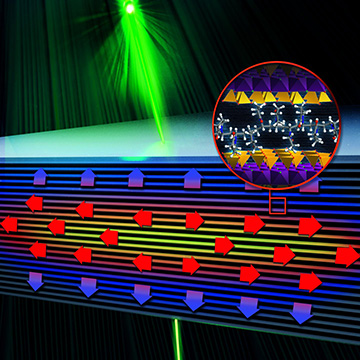
Researchers at the Max Planck Institute for Polymer Research and the University of Bayreuth, Germany, have developed and characterized a nanolayered material, created with a simple spray-on technique, that heat well along the layers while providing thermal insulation across them. [Image: © MPI-P, CC-BY-SA]
Researchers at several German institutions have devised a spray-on method for creating hybrid Bragg stacks—transparent materials built of periodic, alternating layers of material on the order of a nanometer thick. The materials, the team reports, can act much like ultrathin, double-glazed windows, thermally conductive in the in-plane direction and insulating across the plane (Angew. Chem. Intl. Ed., doi: 10.1002/ange.201911546).
The researchers believe that their study of the hybrid material’s thermal and mechanical properties could “have a broad impact” on applications where heat management is important. Such applications, they suggest, could range from thermal dissipation in electronics to the creation of high-performance LEDs.
Mimicking nature
The new study builds on previous work in the heat-transport properties of strongly anisotropic, layered materials, including so-called “nacre mimics”—bio-inspired materials that consist of alternating nano-sheets and polymer layers. Such materials are known to have strongly direction-dependent thermal conductivity. But much less is known about their mechanical properties, and how they deform under stress. That’s a distinct disadvantage for the most sophisticated thermal management applications, since directionally dependent mechanical properties can themselves affect the flow of heat.
To dig into some of these questions, researchers at the Max Planck Institute for Polymer Research and the University of Bayreuth, Germany, began by zeroing in on a specific model system: alternating nanolayers of hectorite (a synthetic, mica-like silicate mineral) and the polymer polyvinylpyrrolidone (PVP). The team also devised an intriguing spray-on method for depositing suspensions of these materials in alternating, ultrathin layers only a nanometer in thickness, with each spraying cycle followed up by a 90-second drying cycle.
Thermal and mechanical anisotropy
The transparent material developed by the Max Planck–Bayreuth team consists of nanometer-thick layers of the synthetic mica-like mineral hectorite (left), interleaved with layers of the polymer polyvinylpyrrolidone (PVP). [Image: Z. Wang et al., Angew. Chem. Intl. Ed., doi: 10.1002/ange.201911546 (2019); CC-BY 4.0] [Enlarge image]
The result of the spray-coating process was a transparent stack of alternating materials, the periodicity of which could be controlled, at the angstrom level, by varying the volume fraction and thickness of the sprayed polymer layers. The researchers then used laser-heating and photoacoustic methods to gauge the thermal conductivity of the materials. They found that their spray-on method could produce transparent films whose thermal conductivity within the layer was as much as 38 times higher than across it.
The team used another optical method, Brillouin light spectroscopy (BLS), to explore the mechanical properties of this hybrid material, and to start to unpack how those properties might correlate with its thermal behavior. BLS measures the Doppler frequency shift in laser light that’s inelastically scattered by phonons, or acoustic energy, in a solid, and has emerged as a common method for sizing up the elastic properties of a material, such as its Young’s modulus and shear modulus. The method allowed the researchers to establish the direction dependence of these mechanical properties in the material, and to correlate those properties with the direction-dependent thermal conductivity.
An application in high-performance LEDs?
The team believes that these observations will contribute to “a wholistic understanding of direction-dependent thermoelastic properties” that will “have a broad impact on important applications such as electronic packaging and thermoelectrics.”
One such application, the researchers believe, could come in the realm of high-performance LEDs. The thought is that the diminutive double-glazed windows created by the researchers’ spray-coating process could form a transparent encapsulating layer that would allow heat from the LED to be carried away laterally.

